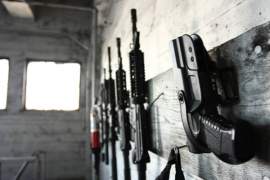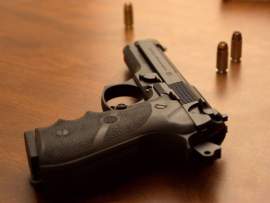
What Are The Gun Control Effects on Crime and Murder

One of the biggest issues involving gun control is directly correlated to its effects on crime and murder. Those who support the gun control movement will claim that imposing stricter firearm laws, violent crimes such as murder will decline because of having the availability of firearms curtailed.
Conversely, individuals that support gun rights and are against gun control will argue that not only does gun control not reduce crime and murder rates, but it actually stimulates them and makes them rise. Very much like the larger scope of the entire gun control debate, it is of no surprise that both opposing factions will reach a stalemate in regarding gun control and its actual effects on crime and murder.
However, it is important to note that arguments and debate on the subject are not the main reason as to being able to determinately claim fact to one or the other, but it is the discrepancy in the statistics and facts themselves that lend to dispute. In measuring the quantifiable effects of gun control on crime and murder, there are two problems that are bound to surface.
Firstly, gun control refers to an all encompassing term that can be linked to the specific laws and regulations enforced by the government restricting firearms as well as the safety measures such as safety components or trigger locks used for firearms and guns.
It is important to see how the interaction of how the various laws and the various governing bodies in the country--meaning the levels of government: federal, state, and local--actually effect crime and murder based on the overall and singular interaction of each provision and enforcement. Because the laws not only vary from the federal to the state level, the further even more so from state to state.
The differing laws lend for the ability to measure the impact on crime to become skewed or insufficient; the various laws do not necessarily allow for a uniform reproduction of empirical data across the board. Secondly, just because the laws are written in to law does not necessarily mean that they are being enforced equally at the different levels of government. It has to be taken in to account the human aspect of fallacy of enforcing the laws as strictly as the law intends, and that not all laws will be enforced as strictly as another.
Such aspects make the measuring of crime and murder and the effect gun control has extremely difficult to calculate, and even more so, to determine accurately. However, statistics are available to show a correlation between gun control and crime, but these will also vary depending which side of the argument is presenting the data, as well as the focus or concentration of specific areas or data in order to prove one of two points: gun control lowers crime and murder, or gun control does not affect crime and murder, and may even influence it to occur more.
The effects that gun control has on crime is almost strictly correlated with crimes that are of a violent nature based on the assumption that firearms will be more likely to be employed in committing such a crime. In general, it has been reported that 60% to 70% of all homicides involve firearms. Out of this firearms, about 80% involved handguns.
Since the implementations of more restrictions and regulations involving the purchases, possession, or carrying of handguns have been more explicitly stressed since the 1970s and 1980s, there has been a general decline of firearm related violent related crimes, particularly homicides. From the early 1990s to turn of the century, this decline has been at a steady average at about 10% each year, with a total decline of about 50%.
Such statistical reports will provide for factual evidence extensively showing how crime can be reduced with pro gun control implementations. Not only do these numbers prove a positive effect about gun control, but it is a drastic and impressive one. Another report showed that there are about 6.3 million violent crimes committed in 1999. Violent crimes including rape or sexual assault, robber, and assault were considered for this statistic.
Out of those crimes, just over 500,000 involved the use of firearms, which is about 8% of the total estimation of violent crimes. This statistic essentially shows that firearms are not necessarily properly correlated with their use during violent crimes, and therefore, extensive gun control laws deem to be excessive and unfair to those citizens legally allowed to own and use them.
An example of how stricter gun control laws did not aid in lowering crime rates is Washington D.C. In 1976, D.C. adopted what was to be considered one of the few extremely restrictive gun control policies in the country. The murder rate since the time of new gun control policy rose 134%. Yet another example is New York City, which also implemented similarly stringent gun laws as D.C. had similar results.
In the early 1970s, about 19 % of homicides involved pistols, and shortly after the new laws were in place, this number rose to about 50%. Furthermore, the restriction of firearms allowed for only 28,000 lawfully possessed or acquired firearms, yet law enforcement estimations had the number at 1.3 million illegal handguns in the city. Conversely, states with fewer restrictions such as New Hampshire and Vermont, have proven to the safest of all the states, with Vermont ranking in at 49th in crime and 47th in murders.
Another important facet to consider is the institution of concealed carry laws. Concealed carry laws allow eligible firearm owners to carry their weapons in a concealed fashion, as allowed by law. Those supporting gun control argued that no one but law enforcement or military personnel has the need to carry firearms in public, and much less so, to do so concealed from clear view. However, states that implemented concealed carry laws saw murder rates drop an average of 8.5%, rapes by about 5%, assault by 7%, and robbery by about 3%.
Texas is a great example, which saw its crime rates drop 50% faster than the rest of the nation; before the passage of the law, crime rates were above the national average by 38%. Unfortunately, the reports regarding gun control and its effects on crime and murder are subject to bias; furthermore, the information is available to those who seek it, but the general public is subject only to media outlets that may choose to present a certain aspect of statistics to further provide for gaining supporters for their own cause.
The focus of violent crimes and gun control has shifted in recent times to the subject of gun violence and youth. Tragedies such as the Columbine High School and Virginia Tech massacres have produced an outcry about gun control implementations being necessary for the protection of children and young adults throughout the country.
It is an alarming situation to consider because this age group, which is considered to be in the range of 14 to 24, seems to increase in terms of commission of violent crimes. From the mid-1980s to the early 1990s, firearm related homicides committed by children from ages 14 to 17 increased from about 850 to just over 3,000, an increase of almost 300%.
The reason as to why the numbers increased so dramatically is still yet to be determined, and just as a fervent argument and debate as gun control; issues constantly blamed include violence in TV and movies, violent or negative lyrics in music, aggressive types of music, etc. Regardless of the reasons why, it is obvious that children are gaining access to firearms in one way or another--most likely their own homes. Gun control supporters would encourage the passage of more strict laws for firearms due to such alarming statistics.
Those against gun control would argue that firearms are not the issue; the acquisition of firearms by children or other unqualified persons is directly caused individuals breaking the law, and not the community of lawful firearms users and owners. Furthermore, a valid point would also prove to be important is the consideration that the parents of children using firearms for violent crimes have to remain responsible for their own children, particularly if the firearm came from their own homes.
Firearms users must be held responsible for the proper storage and safe keeping of their weapons from all people who are unauthorized to them, especially if the weapons are kept in the house for self-defense and young children are living with them. Though it is have been proven the shooters at Columbine acquired their guns from gun shows--which at the time, did not conduct background checks--the access of firearms to children at the home must be regulated by the parents.
The effects of the Columbine shooting were a result of a community stricken by horror and anger, and demanded immediate action. Though nothing happened immediately at the federal level, Colorado passed legislature that required stricter regulations for gun shows in the state. The tragedies at both Columbine and Virginia Tech have slowly pushed pro gun control sentiments in the direction of instituting further legislation on firearms, even with the support of the NRA for stricter background checks.
However, the acts of violence themselves and gun control show that there may be a correlation between the availability of guns and crime. What the relationship is still undetermined for such contradictory data exists that can trump and repel arguments given by both sides of the gun control debate, pro gun control and against gun control.
NEXT: What Are The Gun Control Legislative Priorities




















